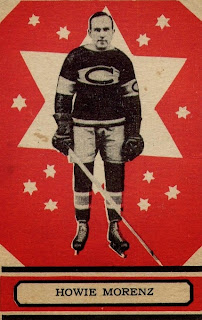The names our parents gave us never
seem to be good enough! Quite often we’re handed a new moniker that
better describes us physically, emotionally or mentally. Professional
sports used to be the breeding grounds of great nicknames but not so
much anymore.
Test and expand your knowledge of
National Hockey League players and their unique nicknames with the
following four hockey trivia
questions.
Q. What Toronto Maple Leafs legend was
dubbed “The Big Bomber”?
A. Charlie Conacher was also called
“Little Train”. The Big Bomber played in the NHL from 1929-30 to
1940-41 with Toronto, the Detroit Red Wings and New York Americans.
He later coached the Chicago Black Hawks for three years from 1947-48
to 1949-50. The Hawks did not make the playoffs during Charlie’s
tenure. Conacher was inducted into the Hockey Hall of Fame in 1961.
Brother Lionel was “The Big Train”.
Lionel played in the NHL from 1925-26 to 1936-37 with the Pittsburgh
Pirates, New York Americans, Montreal Maroons and Chicago Blackhawks.
Other brother Roy simply went by “Roy”. He played in the NHL from
1938-39 to 1951-52 with the Boston Bruins, Detroit Red Wings and
Chicago Blackhawks. All three Conacher brothers have a place in the
Hockey Hall of Fame.
Charlie's son, Brian Conacher, also played in the National Hockey League.
Q. What agitator who played the bulk of
his NHL career in the 1970’s and 1980’s was coined “The Rat”?
A. Ken Linseman had a great talent for
getting under the skin of his opponents but also had a great talent
for playing the game. The Rat played in the NHL from 1978-79 to
1991-92 with the Philadelphia Flyers, Boston Bruins, Edmonton Oilers
and Toronto Maple Leafs. Linseman ended his NHL career with a
respectable 807 points in 860 regular season games and averaged over
a point per game in his 113 playoff games.
Linseman was a 60 goal scorer in junior
with the Kingston Canadians. He topped out in the NHL with 33 goals
as a member of the Edmonton Oilers in 1982-83. In 1981-82, Ken had a
career high 92 points with the Flyers. He was a seventh overall pick
by the Flyers at the 1978 NHL Amateur Draft and won his only Stanley
Cup with the Oilers in 1983-84.
Q. What NHL legend was nicknamed “The
Stratford Streak”, despite being from nearby Mitchell, Ontario?
A. Howie Morenz was perhaps one of the
greatest hockey players ever to grace the NHL. Morenz played in the
NHL from 1923-24 to 1936-37 with the Montreal Canadiens, Chicago
Black Hawks and New York Rangers. He won the Hart Memorial Trophy as
NHL MVP three times, all as a member of the Montreal Canadiens. With
the Habs, Howie was part of three Stanley Cup championship teams.
Morenz died in 1937 as a result of complications from a broken leg
that occurred while playing for the Canadiens. He was just 34 years
old. Howie was inducted into the Hockey Hall of Fame in 1945.
Yes, Morenz was born in Mitchell,
Ontario. The sign as you're entering the small town proudly displays
this fact. Indeed, it should. Yes, Howie played his minor hockey in
nearby Stratford, Ontario where he earned the nickname.
Q. This question is in reverse because
everyone knows Gump Worsley by his nickname and not his real first
name. What was the real first name of Mr. Worsley?
A. Lorne Worsley played between the
pipes in the NHL from 1952-53 to 1973-74 with the New York Rangers,
Montreal Canadiens and Minnesota North Stars. Worsley won the Calder
Memorial Trophy in 1952-53 as the NHL’s top rookie. He won the
Vezina Trophy twice with the Montreal Canadiens. Gump was inducted
into the Hockey Hall of Fame in 1980 and passed away in 2007.
Worsley is one of a special group of
athletes that have had their real names dropped by fellow players and
fans, replaced by a nickname. Irvine and Garnet are two Bailey's that
are both much better known as "Ace". Frank McGraw Junior is known
throughout the sporting world as "Tug". McGraw is one of the great
relief pitchers in MLB history.



















